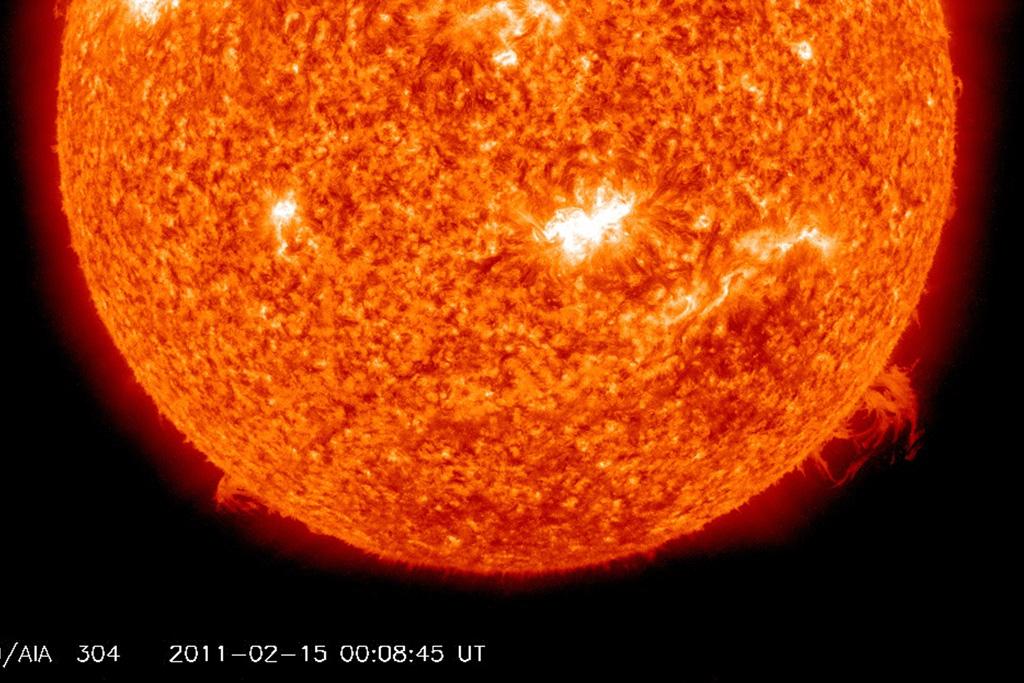Solar storm hits Earth after huge solar flare (VIDEO)
The first strong solar flare in four years occurred on Feb. 14, 2011, as captured here by NASA’s Solar Dynamics Observatory spacecraft. This solar flare led to warnings that a geo-magnetic storm could disrupt communications and electrical supplies once it reaches the earth’s magnetic field. Another solar storm is hitting the Earth on Jan. 24, 2011.
A solar storm is hitting Earth today following a huge solar flare eruption Sunday that sent radiation hurtling towards our planet.
The resulting geomagnetic storm, the biggest since 2005, could disrupt GPS and satellite communications, although the threat is low, scientists say.
Today's solar storm could also cause unusually intense Northern Lights, the San Francisco Chronicle reported. The aurora borealis may be visible at lower latitudes than usual.
Photos from GlobalPost: Aurora Borealis: Rare Northern Lights Illuminate Skies Red Across North America
The solar flare, an eruption called a "coronal mass ejection," or CME, by scientists, has sent billions of tons of gas and charged particles streaming towards Earth at 2,200 km/s.
Some international airlines rerouted planes from polar areas to routes where radio communication is less likely to be affected by the geomagnetic storm, the Chronicle reported.
The solar flare was observed by NASA's Solar Dynamics Observatory and erupted from a sunspot on Monday, SpaceWeather.com reported.
More from GlobalPost: Solar storm: Delta, United Airlines divert flights over Arctic
News24 reported that the solar storm may have a particular impact in South Africa because of the South Atlantic Anomaly where the Earth's magnetic field is weakest.
South Africans have been told to avoid being exposed directly to the sun in the early afternoon local time, when the storm is expected to hit its peak.
SpaceWeather.com said the M9-class solar flare, also called an X-flare, could "cause isolated reboots of computers onboard Earth-orbiting satellites and interfere with polar radio communications."
More from GlobalPost: Cosmic Katrinas — a solar super-storm could cost $2 trillion
The Sun is in an increasingly active period of its normal 11-year cycle, also known as a "solar maximum," VOA reported. Sun activity is expected to peak next year.
The sun goes through 11-year cycles of violent electromagnetic activity marked by intense sunspot regions on the surface, and right now it is moving from a "sunspot minimum" period toward a peak of activity with more intense and frequent magnetic storms during the next few years.
"The sun is waking up from a deep slumber, and in the next few years we expect to see much higher levels of solar activity," Richard Fisher, head of NASA's Heliophysics Division, reportedly said last year. "At the same time, our technological society has developed an unprecedented sensitivity to solar storms."
VOA said that while the current solar storm is the biggest in seven years, it "does not pose a threat to life on the planet."
The US-based Solar & Heliospheric Observatory (SOHO), a collaboration between NASA and the European Space Agency, released a video showing a recent solar flare:
The article you just read is free because dedicated readers and listeners like you chose to support our nonprofit newsroom. Our team works tirelessly to ensure you hear the latest in international, human-centered reporting every weekday. But our work would not be possible without you. We need your help.
Make a gift today to help us reach our $25,000 goal and keep The World going strong. Every gift will get us one step closer.
